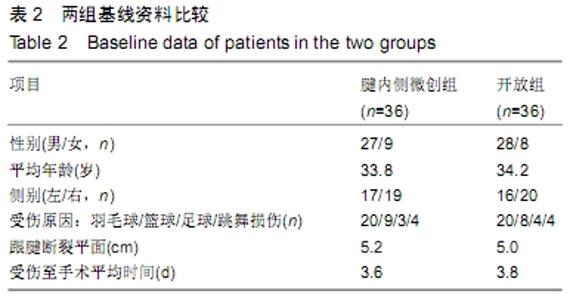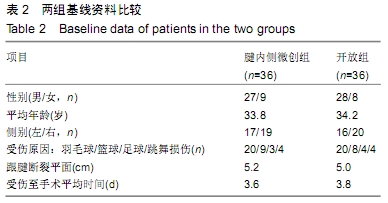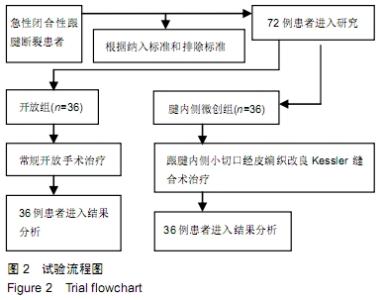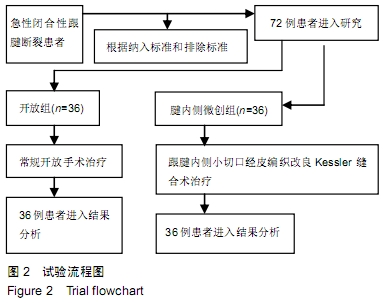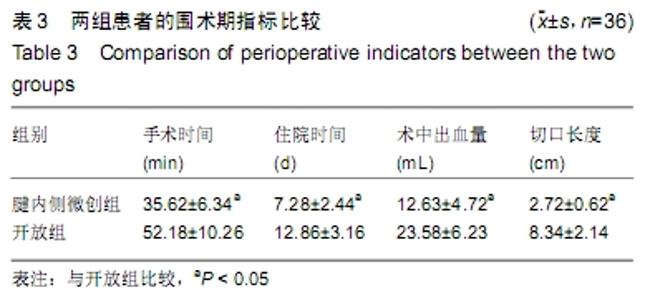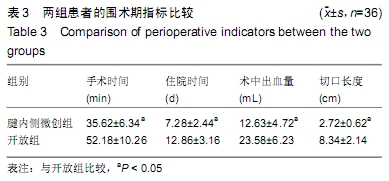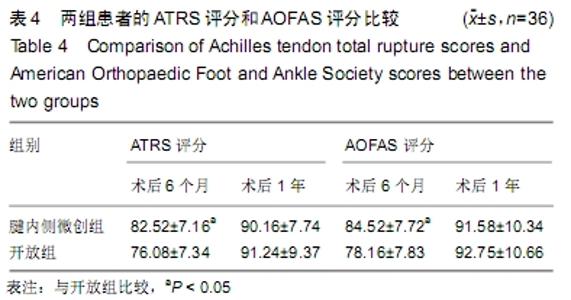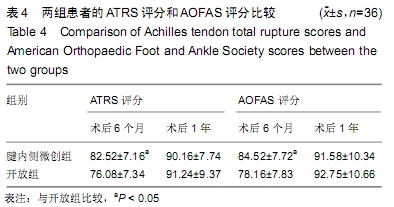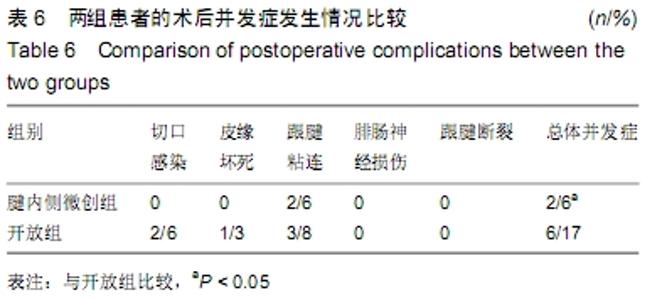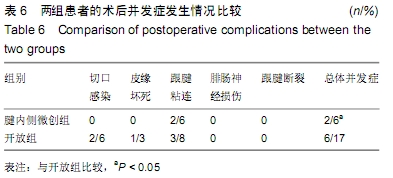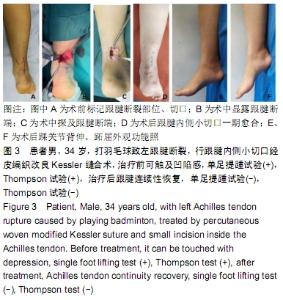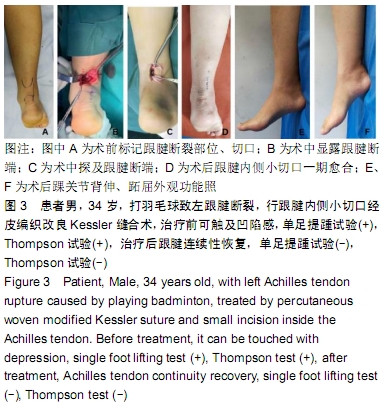[1]YIN L, WU Y, REN C, et al. Treatment of acute achilles tendon rupture with the panda rope bridge technique. Injury. 2018;49(3):726-729.
[2]UQUILLAS CA, GUSS MS, RYAN DJ, et al. Everything Achilles: Knowledge Update and Current Concepts in Management: AAOS Exhibit Selection. J Bone Joint Surg Am. 2015;97(14):1187-1195.
[3]GANESTAM A, KALLEMOSE T, TROELSEN A, et al. Increasing incidence of acute Achilles tendon rupture and a noticeable decline in surgical treatment from 1994 to 2013. A nationwide registry study of 33,160 patients. Knee Surg Sports Traumatol Arthrosc.2016;24(12): 3730-3737.
[4]JONES MP, KHAN RJ, CAREY SMITH RL. Surgical interventions for treating acute achilles tendon rupture: key findings from a recent cochrane review. J Bone Joint Surg Am. 2012;94(12):e88.
[5]柴明祥,何泽阳,吴希瑞.经皮与开放缝合治疗急性闭合性跟腱断裂的临床研究[J].中国矫形外科杂志,2016,24(8):711-716.
[6]陈柯屹,曹万军,张梦苑.非手术与手术修复急性闭合性跟腱断裂的Meta分析[J].中国组织工程研究,2015,19(15):2449-2454.
[7]HSU AR, JONES CP, COHEN BE, et al. Clinical Outcomes and Complications of Percutaneous Achilles Repair System Versus Open Technique for Acute Achilles Tendon Ruptures. Foot Ankle Int. 2015; 36(11):1279-1286.
[8]王玮.运动性跟腱断裂:原因、治疗与如何评价跟腱的力学特性及愈合程度[J].中国组织工程研究,2018,22(8):1300-1305.
[9]毛仁群,陈传煌,王培吉,等.微创手术治疗急性闭合性跟腱断裂[J].中国矫形外科杂志,2019,27(13):1229-1232.
[10]李志超.新型小切口微创缝合技术治疗急性闭合性跟腱断裂的效果观察[J].微创医学,2018,13(1):103-105.
[11]刘蒙,曲巍,赵巍.双津下套圈缝合法与跟腱龙技术治疗急性跟腱断裂的比较[J].中国矫形外科杂志,2019,27(6):515-519.
[12]姚兴璋,李兴勇,蒋振兴,等.经皮微创锚钉缝合修复急性闭合性跟腱断裂的临床疗效[J].中华创伤杂志,2018,34(6):521-526.
[13]苏柯,柳嘉伟,黄鑫,等.急性闭合性跟腱断裂预后与III型胶原比例的关系研究[J].中国骨与关节杂志,2018,7(10):788-792.
[14]AISAIDING A, WANG J, MAIMAITI R, et al. A novel minimally invasive surgery combined with early exercise therapy promoting tendon regeneration in the treatment of spontaneous Achilles tendon rupture. Injury. 2018;49(3):712-719.
[15]赵飞,巩凡,李晓亮,等.急性闭合性跟腱断裂28例患者的5年随访研究[J].中华显微外科杂志,2017,40(4):324-327.
[16]李军,詹俊锋,石志刚,等.两种方法治疗急性闭合跟腱断裂的疗效比较[J].临床骨科杂志,2017,20(3):362-365.
[17]丁凯,丁亮华,丁文鸽,等.经皮微创缝合与传统切开缝合治疗急性闭合性跟腱断裂的比较研究[J].中华创伤骨科杂志,2018,20(12):1054-1059.
[18]王波,闫康,安明,等.改良经皮微创修复术治疗急性闭合性跟腱断裂的临床疗效研究[J].创伤外科杂志,2019,21(7):492-496.
[19]王旭,王晨,张超,等.有限切开卵圆钳辅助引线微创技术治疗急性闭合性跟腱断裂[J].中华创伤骨科杂志,2014,16(10):858-861.
[20]田建,许亚军,陈政,等.有限小切口下简易Krackow缝合法治疗急性闭合性跟腱断裂的疗效观察[J].中国修复重建外科杂志,2017,31(11):1322-1325.
[21]MAJEWSKI M, ROHRBACH M, CZAJA S, et al. Avoiding sural nerve injuries during percutaneous Achilles tendon repair. Am J Sports Med. 2006;34(5):793-798.
[22]LACOSTE S, FÉRON JM, CHERRIER B. Percutaneous Tenolig(®) repair under intra-operative ultrasonography guidance in acute Achilles tendon rupture. Orthop Traumatol Surg Res. 2014;100(8): 925-930.
[23]FLAVIN R, GIBNEY RG, O'ROURKE SK. A clinical test to avoid sural nerve injuries in percutaneous Achilles tendon repairs. Injury. 2007; 38(7):845-847.
[24]李永耀,程灏,朱立国,等.应用带针爱惜邦线微创治疗急性闭合性跟腱断裂37例[J].中国中医骨伤科杂志,2019,27(9):59-61,64.
[25]陈传煌,杨涛,李文庆,等.急性跟腱断裂微创与传统修复方法的比较[J].中国临床解剖学杂志,2014,32(4):487-490.
[26]AIBINDER WR, PATEL A, ARNOUK J, et al. The rate of sural nerve violation using the Achillon device: a cadaveric study. Foot Ankle Int. 2013;34(6):870-875.
[27]胡燕青,蒋海,李棋,等.不同肌腱缝合方法的生物力学比较研究[J].中国修复重建外科杂志,2017,31(10):1208-1213.
[28]洪劲松,付小勇,杨仲.经皮小切口微创修复急性闭合性跟腱断裂的疗效观察[J].足踝外科电子杂志,2016,3(1):26-29.
[29]林勇彬,郭跃跃,庄怀铭,等.小切口Kessler缝合法治疗新鲜闭合性跟腱断裂[J].中华创伤骨科杂志,2011,13(7):693-694.
[30]汤明,李谓林,鲁齐林,等.塑型卵圆钳经皮缝合与切开缝合治疗新鲜闭合性跟腱断裂的对照研究[J].骨科,2019,10(3):173-178,183.
|
